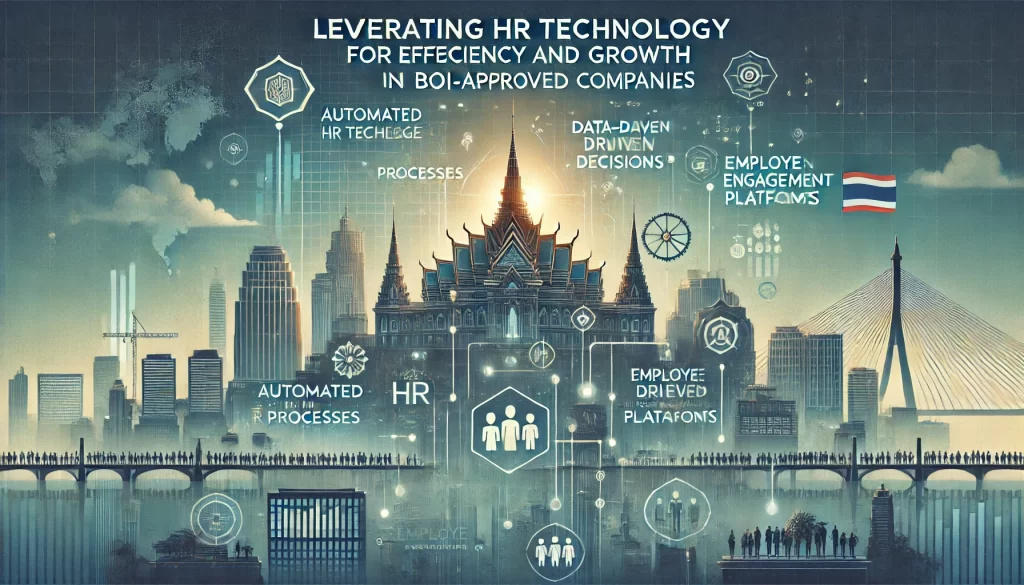In today’s fast-paced business landscape, Board of Investment (BOI)-approved companies face a unique challenge: how to maintain efficiency and drive growth while navigating complex regulatory requirements. 🏢💼 The solution? Harnessing the power of HR technology.
Imagine a world where your HR processes are streamlined, your employees are engaged, and your company’s growth is accelerated. This isn’t just a dream – it’s the reality for BOI-approved companies that have embraced cutting-edge HR tech solutions. From recruitment to retention, from payroll to performance management, HR technology is revolutionizing the way these companies operate. 🚀💻
In this blog post, we’ll explore how BOI-approved companies can leverage HR technology to boost efficiency and fuel growth. We’ll dive into key areas such as streamlining recruitment, enhancing performance management, optimizing payroll administration, and much more. Get ready to discover how your company can stay ahead of the curve and thrive in the competitive world of BOI-approved businesses! 🌟📈
Understanding HR Technology in BOI-Approved Companies

A. Definition and scope of HR technology
HR technology, or HR tech, refers to the suite of digital tools and software solutions designed to streamline and automate various human resource management processes. For BOI-approved companies, HR tech encompasses a wide range of applications, from basic employee data management to advanced analytics and artificial intelligence-driven decision-making tools.
| HR Tech Category | Examples |
|---|---|
| Core HR | HRIS, Employee Self-Service Portals |
| Talent Management | Applicant Tracking Systems, Performance Management Software |
| Workforce Management | Time and Attendance, Scheduling Tools |
| Learning and Development | Learning Management Systems, E-learning Platforms |
| Analytics | HR Dashboards, Predictive Analytics Tools |
B. Importance for BOI-approved companies
HR technology is crucial for BOI-approved companies due to several factors:
- Increased efficiency in HR operations
- Improved compliance with labor laws and regulations
- Enhanced employee experience and engagement
- Data-driven decision-making capabilities
- Scalability to support company growth
By leveraging HR tech, BOI-approved companies can maintain a competitive edge in talent acquisition and retention, crucial for their success in the global market.
C. Key features of modern HR tech solutions
Modern HR tech solutions offer a variety of features tailored to the needs of BOI-approved companies:
- Cloud-based accessibility for remote work
- Mobile compatibility for on-the-go management
- AI-powered chatbots for employee queries
- Automated workflow processes
- Real-time analytics and reporting
- Integration capabilities with other business systems
These features enable HR departments to focus on strategic initiatives rather than administrative tasks, driving overall organizational efficiency and growth. As we explore further, we’ll see how these technologies can be applied to specific HR functions within BOI-approved companies.
Streamlining Recruitment and Onboarding

Automated applicant tracking systems
Automated applicant tracking systems (ATS) have revolutionized the recruitment process for BOI-approved companies. These systems streamline candidate management, saving time and resources while improving the quality of hires. Here’s how ATS benefits organizations:
- Centralized candidate database
- Automated resume screening
- Simplified job posting across multiple platforms
- Improved collaboration among hiring teams
- Enhanced reporting and analytics
| Feature | Benefit |
|---|---|
| Resume parsing | Quickly extracts and organizes candidate information |
| Customizable workflows | Tailors the hiring process to company needs |
| Integration capabilities | Connects with other HR tools for seamless operations |
AI-powered candidate screening
AI-powered screening tools take recruitment efficiency to the next level. These intelligent systems analyze resumes, assess candidate qualifications, and even conduct initial interviews, significantly reducing the time-to-hire.
Digital onboarding processes
Digital onboarding transforms the new employee experience, ensuring a smooth transition into the organization. Key components include:
- Electronic document signing
- Virtual orientation sessions
- Interactive training modules
- Automated task assignment and tracking
Compliance management for BOI regulations
For BOI-approved companies, maintaining compliance is crucial. HR technology offers robust solutions to manage complex regulatory requirements:
- Automated document collection and verification
- Real-time updates on regulatory changes
- Customizable compliance checklists
- Audit trail generation for transparency
By leveraging these HR technologies, BOI-approved companies can create a more efficient and effective recruitment and onboarding process, setting the stage for long-term employee success and organizational growth.
Enhancing Employee Performance Management

Goal-setting and tracking tools
In BOI-approved companies, implementing effective goal-setting and tracking tools is crucial for enhancing employee performance management. These tools provide a structured approach to setting, monitoring, and achieving objectives.
Here are some key features of goal-setting and tracking tools:
- SMART goal framework
- Progress tracking dashboards
- Milestone notifications
- Team collaboration features
- Integration with performance reviews
| Tool Feature | Benefit |
|---|---|
| SMART goal framework | Ensures goals are Specific, Measurable, Achievable, Relevant, and Time-bound |
| Progress tracking dashboards | Provides real-time visibility into goal progress |
| Milestone notifications | Keeps employees and managers informed of key achievements |
| Team collaboration features | Facilitates alignment and support among team members |
| Integration with performance reviews | Links goal achievement to overall performance evaluation |
Continuous feedback mechanisms
Continuous feedback mechanisms are essential for maintaining ongoing communication between employees and managers. These tools enable real-time performance discussions, fostering a culture of open dialogue and continuous improvement.
Key components of continuous feedback mechanisms include:
- Regular check-ins
- 360-degree feedback systems
- Peer recognition platforms
- Instant messaging for quick feedback
- Performance journal features
Data-driven performance evaluations
Data-driven performance evaluations leverage HR technology to provide objective insights into employee performance. By utilizing data analytics, companies can make more informed decisions about employee development, promotions, and compensation.
Key aspects of data-driven performance evaluations:
- Quantifiable performance metrics
- Trend analysis over time
- Comparative benchmarking
- Skill gap identification
- Predictive performance modeling
Aligning individual goals with company objectives
Aligning individual goals with company objectives is crucial for ensuring that employee efforts contribute directly to organizational success. HR technology can facilitate this alignment by providing tools that connect personal targets to broader company goals.
Strategies for goal alignment include:
- Cascading goals from top-down
- Visualizing goal connections
- Regular goal review and adjustment
- Cross-departmental goal visibility
- Linking individual objectives to company KPIs
By implementing these performance management strategies, BOI-approved companies can create a more engaged and productive workforce, driving efficiency and growth.
Optimizing Payroll and Benefits Administration

Automated payroll processing
Automated payroll processing is a game-changer for BOI-approved companies, streamlining operations and reducing errors. Here’s how it benefits organizations:
- Time savings: Reduces manual calculations and data entry
- Accuracy: Minimizes human errors in payroll calculations
- Compliance: Automatically applies tax regulations and deductions
- Reporting: Generates detailed reports for financial analysis
Self-service portals for employees
Employee self-service portals empower staff to manage their own information, reducing HR workload:
- Access pay stubs and tax documents
- Update personal information
- View and manage leave balances
- Submit expense reports
Integration with financial systems
Seamless integration between payroll and financial systems offers several advantages:
| Benefit | Description |
|---|---|
| Real-time data | Instant financial updates for accurate reporting |
| Reduced duplication | Eliminates need for manual data transfer |
| Improved auditing | Easier tracking of financial transactions |
| Cost savings | Reduces administrative overhead |
Ensuring compliance with BOI payroll regulations
Staying compliant with BOI regulations is crucial for approved companies. HR technology helps by:
- Automatically updating tax tables and contribution rates
- Generating required reports for BOI submissions
- Tracking employee work hours and overtime
- Maintaining detailed records for auditing purposes
By leveraging these HR technology solutions, BOI-approved companies can significantly improve their payroll and benefits administration processes, leading to increased efficiency and reduced compliance risks.
Facilitating Learning and Development

E-learning platforms and content management
In the digital age, e-learning platforms have become essential tools for facilitating learning and development in BOI-approved companies. These platforms offer a centralized hub for managing and delivering educational content, making it easier for employees to access training materials anytime, anywhere.
Key features of e-learning platforms include:
- Course creation and management
- Content libraries
- Assessment tools
- Progress tracking
- Mobile compatibility
| Feature | Benefit |
|---|---|
| Course creation | Customized learning experiences |
| Content libraries | Wide range of ready-made materials |
| Assessment tools | Measure learning effectiveness |
| Progress tracking | Monitor employee development |
| Mobile compatibility | Learn on-the-go |
Skill gap analysis tools
Identifying skill gaps is crucial for targeted employee development. Advanced HR technology offers sophisticated skill gap analysis tools that help companies:
- Assess current employee competencies
- Compare skills against job requirements
- Identify areas for improvement
- Prioritize training needs
These insights enable HR managers to create targeted learning programs that address specific organizational needs.
Personalized learning paths
With the help of AI and machine learning, HR technology can now create personalized learning paths for each employee. This tailored approach considers:
- Individual skill levels
- Career aspirations
- Learning preferences
- Job requirements
By offering customized learning experiences, companies can significantly improve engagement and knowledge retention among their workforce.
Tracking and reporting on training progress
Effective learning and development initiatives require robust tracking and reporting capabilities. Modern HR technology provides comprehensive analytics that allow companies to:
- Monitor completion rates
- Assess knowledge retention
- Evaluate training effectiveness
- Generate compliance reports
These insights help HR managers refine their training strategies and demonstrate the ROI of learning and development programs to stakeholders.
Improving Employee Engagement and Retention

Pulse surveys and sentiment analysis
In today’s fast-paced work environment, staying connected with employee sentiment is crucial. Pulse surveys offer a quick and efficient way to gauge employee opinions and feelings. These short, frequent surveys provide real-time insights into workforce morale, allowing HR teams to address issues promptly.
Sentiment analysis tools take this a step further by:
- Analyzing survey responses for emotional tone
- Identifying trends in employee satisfaction
- Highlighting areas of concern before they escalate
Here’s a comparison of traditional annual surveys vs. pulse surveys:
| Feature | Annual Surveys | Pulse Surveys |
|---|---|---|
| Frequency | Once a year | Weekly or monthly |
| Length | Long, comprehensive | Short, focused |
| Response rate | Often low | Generally higher |
| Data relevance | May be outdated | Real-time insights |
| Action time | Slow | Rapid |
Recognition and reward systems
Implementing digital recognition platforms can significantly boost employee morale and productivity. These systems allow for:
- Peer-to-peer recognition
- Public acknowledgment of achievements
- Gamification of rewards
- Integration with performance metrics
Career development planning tools
Modern HR technology offers sophisticated career development tools that empower employees to take charge of their professional growth. These platforms typically include:
- Skill gap analysis
- Personalized learning recommendations
- Goal-setting and tracking features
- Mentorship matching algorithms
Analytics for predicting and preventing turnover
Predictive analytics in HR technology can be a game-changer for retention efforts. By analyzing various data points, these tools can:
- Identify employees at risk of leaving
- Suggest targeted retention strategies
- Forecast future workforce needs
- Evaluate the effectiveness of retention initiatives
With these insights, HR teams can proactively address potential issues, ensuring a more stable and engaged workforce. As we move forward, we’ll explore how data analytics can further enhance strategic decision-making in BOI-approved companies.
Leveraging Data Analytics for Strategic Decision-Making

HR dashboards and visualizations
HR dashboards and visualizations are powerful tools that transform complex data into easily digestible visual representations. These tools provide real-time insights into key HR metrics, enabling decision-makers to quickly identify trends, patterns, and areas for improvement.
Here are some essential components of effective HR dashboards:
- Key Performance Indicators (KPIs)
- Employee demographics
- Recruitment metrics
- Performance data
- Retention rates
| Dashboard Element | Purpose |
|---|---|
| KPI Scorecards | Track progress towards HR goals |
| Trend Charts | Visualize changes over time |
| Heat Maps | Identify hotspots or problem areas |
| Pie Charts | Show proportions of different categories |
| Bar Graphs | Compare different metrics or departments |
Predictive analytics for workforce planning
Predictive analytics uses historical data and statistical algorithms to forecast future trends and outcomes. In workforce planning, this technology helps HR professionals make data-driven decisions about hiring, retention, and skill development.
Key applications of predictive analytics in HR include:
- Forecasting talent needs
- Identifying flight risks
- Predicting employee performance
- Optimizing recruitment strategies
Benchmarking against industry standards
Benchmarking allows BOI-approved companies to compare their HR metrics against industry standards, identifying areas where they excel and where improvements are needed. This process involves:
- Selecting relevant metrics
- Gathering data from industry reports and surveys
- Analyzing the company’s performance against benchmarks
- Identifying gaps and opportunities for improvement
ROI measurement of HR initiatives
Measuring the return on investment (ROI) of HR initiatives is crucial for demonstrating the value of HR technology and justifying future investments. This process involves:
- Defining clear objectives for each initiative
- Establishing key performance indicators (KPIs)
- Collecting data before and after implementation
- Calculating the financial impact of improvements
- Presenting results to stakeholders
By leveraging these data analytics techniques, BOI-approved companies can make more informed decisions, optimize their HR processes, and drive overall business growth.
Ensuring Data Security and Compliance

Robust data protection measures
In the digital age, protecting sensitive employee data is paramount for BOI-approved companies. Implementing robust data protection measures is crucial to safeguard against potential breaches and maintain trust. Here are key strategies to consider:
- Encryption: Utilize strong encryption algorithms for data at rest and in transit
- Multi-factor authentication: Implement additional layers of security beyond passwords
- Regular backups: Ensure data is securely backed up and easily recoverable
- Network segmentation: Isolate sensitive HR data from other company networks
| Protection Measure | Purpose | Implementation Difficulty |
|---|---|---|
| Encryption | Data confidentiality | Moderate |
| Multi-factor authentication | Access control | Easy |
| Regular backups | Data recovery | Easy |
| Network segmentation | Breach containment | Complex |
Regular security audits and updates
Maintaining a secure HR technology infrastructure requires vigilance and proactive measures. Regular security audits and timely updates are essential to identify vulnerabilities and address emerging threats.
Compliance with data privacy regulations
BOI-approved companies must adhere to strict data privacy regulations. This includes:
- GDPR compliance for handling EU employee data
- Local data protection laws specific to the company’s operating jurisdiction
- Industry-specific regulations that may apply to certain sectors
Employee data access controls
Implementing granular access controls ensures that only authorized personnel can view or modify sensitive employee information. This involves:
- Role-based access control (RBAC)
- Principle of least privilege
- Regular access reviews and adjustments
By prioritizing these security and compliance measures, BOI-approved companies can protect their HR data assets and maintain regulatory compliance. This foundation of trust and security enables organizations to fully leverage HR technology for efficiency and growth.
Integrating HR Technology with Other Business Systems

Seamless connection with ERP systems
Integrating HR technology with Enterprise Resource Planning (ERP) systems is crucial for BOI-approved companies to achieve operational excellence. This integration allows for real-time data sharing between HR and other departments, streamlining processes and reducing data redundancy.
| Benefits of HR-ERP Integration |
|---|
| Unified data management |
| Improved decision-making |
| Enhanced productivity |
| Reduced administrative burden |
By connecting HR systems with ERP, companies can:
- Automatically update employee information across all systems
- Streamline financial processes related to payroll and benefits
- Improve workforce planning and resource allocation
Integration with project management tools
Linking HR technology with project management tools enables better resource allocation and performance tracking. This integration provides project managers with up-to-date information on employee skills, availability, and workload.
Key advantages include:
- Accurate resource forecasting
- Improved project staffing decisions
- Enhanced performance evaluation based on project contributions
Syncing with communication platforms
Integrating HR systems with communication platforms fosters better collaboration and information sharing. This synchronization ensures that HR-related updates, announcements, and policies reach employees efficiently.
Benefits of this integration:
- Centralized communication channels for HR-related matters
- Improved employee engagement through timely notifications
- Streamlined onboarding and offboarding processes
Creating a unified technology ecosystem
By integrating HR technology with various business systems, BOI-approved companies can create a cohesive technological environment. This unified ecosystem promotes data consistency, improves decision-making, and enhances overall operational efficiency.
A well-integrated system allows for:
- Seamless data flow across departments
- Holistic view of organizational performance
- Improved compliance and reporting capabilities
With this integrated approach, companies can leverage their HR technology investments to drive growth and maintain a competitive edge in the market.
HR technology has become a game-changer for BOI-approved companies, offering a wide array of tools to streamline operations and drive growth. From simplifying recruitment and onboarding processes to enhancing performance management and optimizing payroll administration, these technologies are revolutionizing how HR departments function. Moreover, they play a crucial role in facilitating employee learning, improving engagement, and leveraging data analytics for strategic decision-making.
As companies continue to evolve in the digital age, embracing HR technology is no longer optional but essential for staying competitive. By integrating these solutions with other business systems and ensuring data security and compliance, BOI-approved companies can create a more efficient, productive, and employee-centric workplace. Ultimately, the successful implementation of HR technology will not only boost operational efficiency but also contribute significantly to the overall growth and success of the organization.

